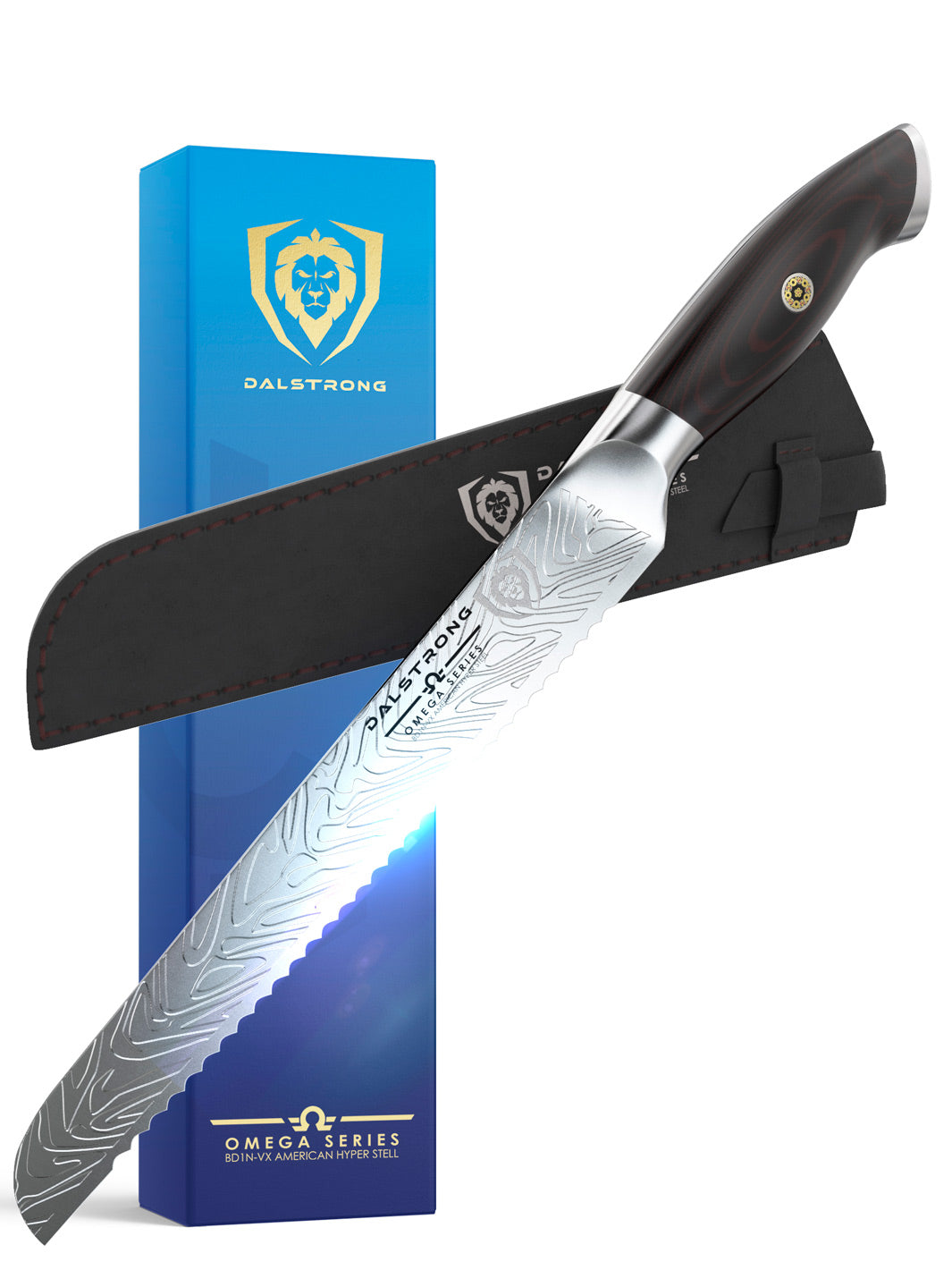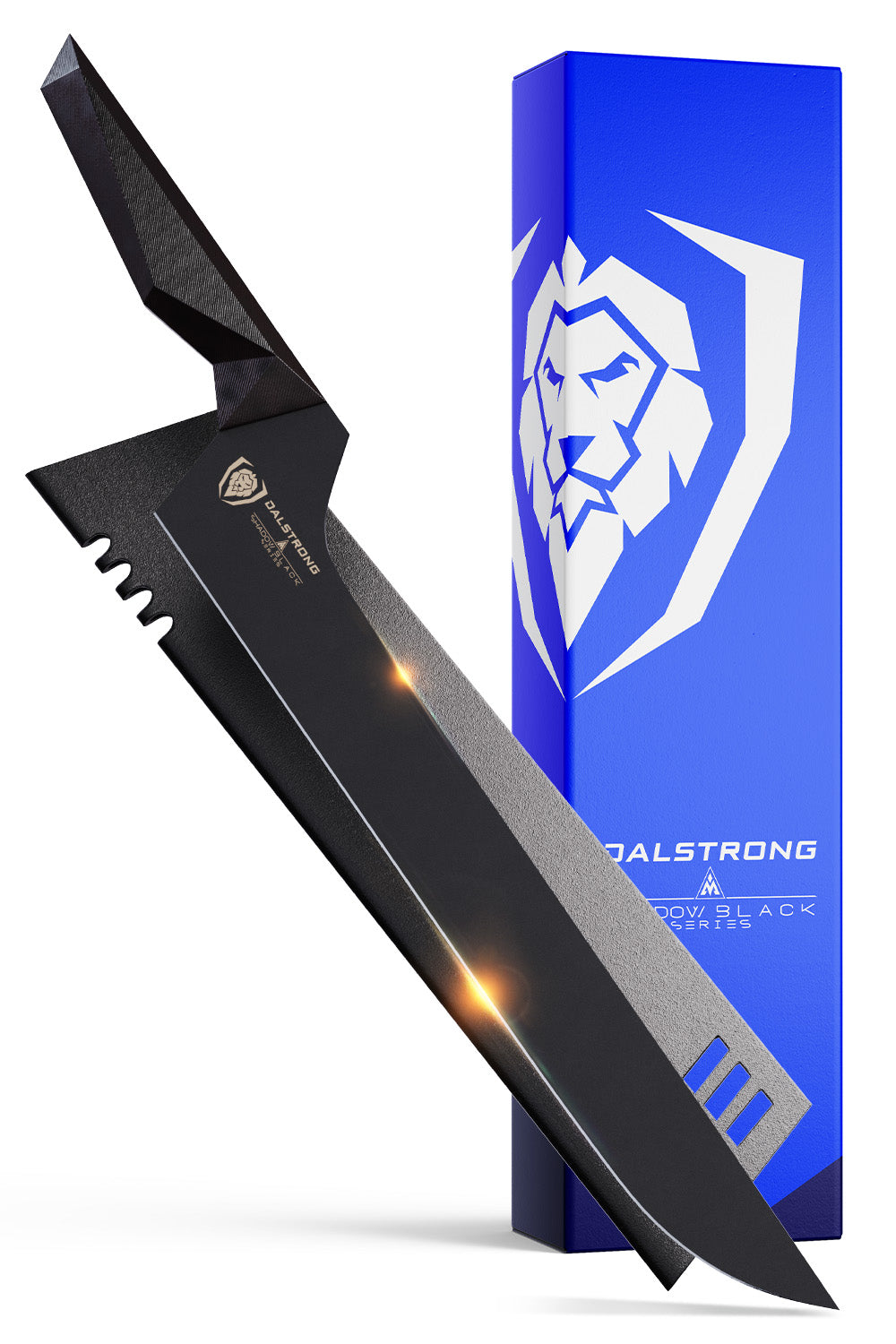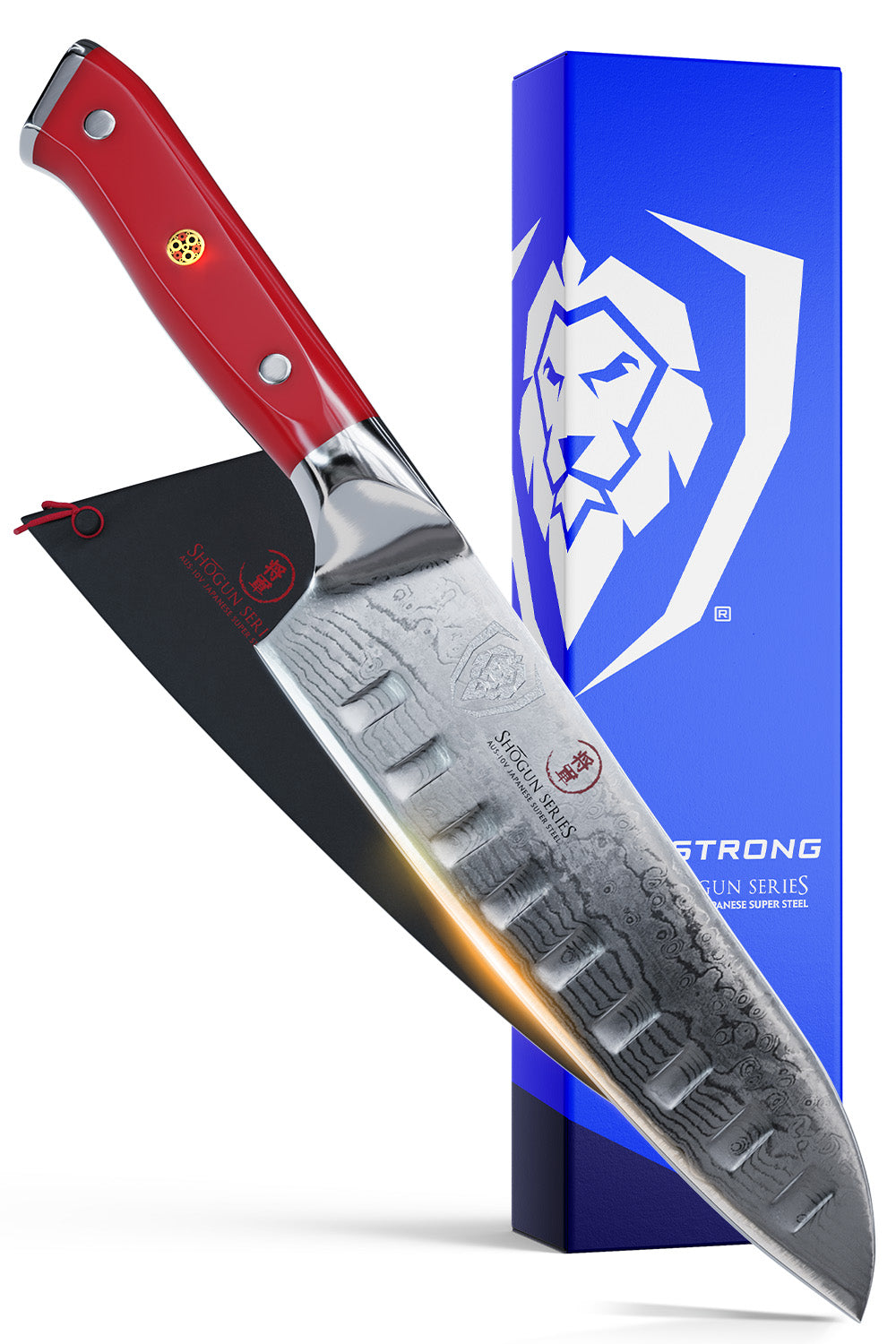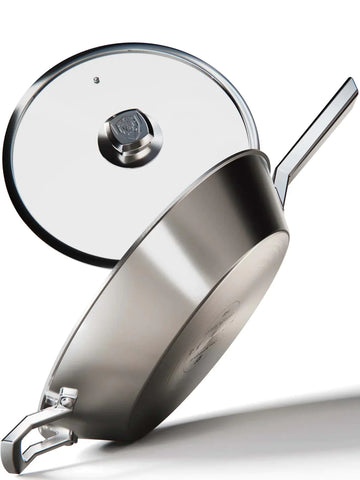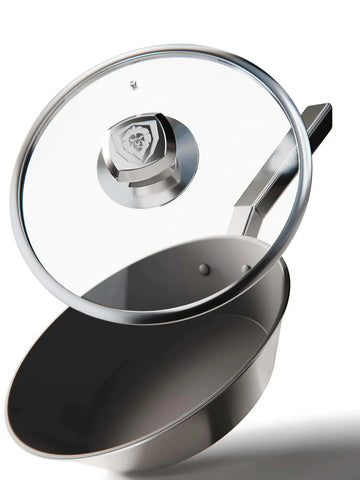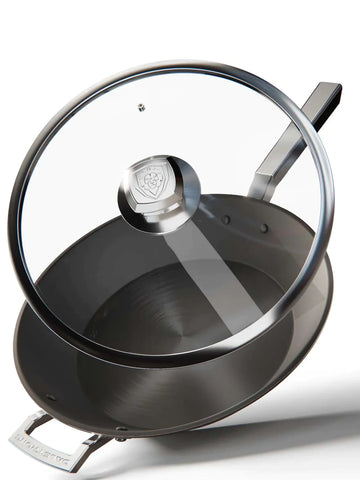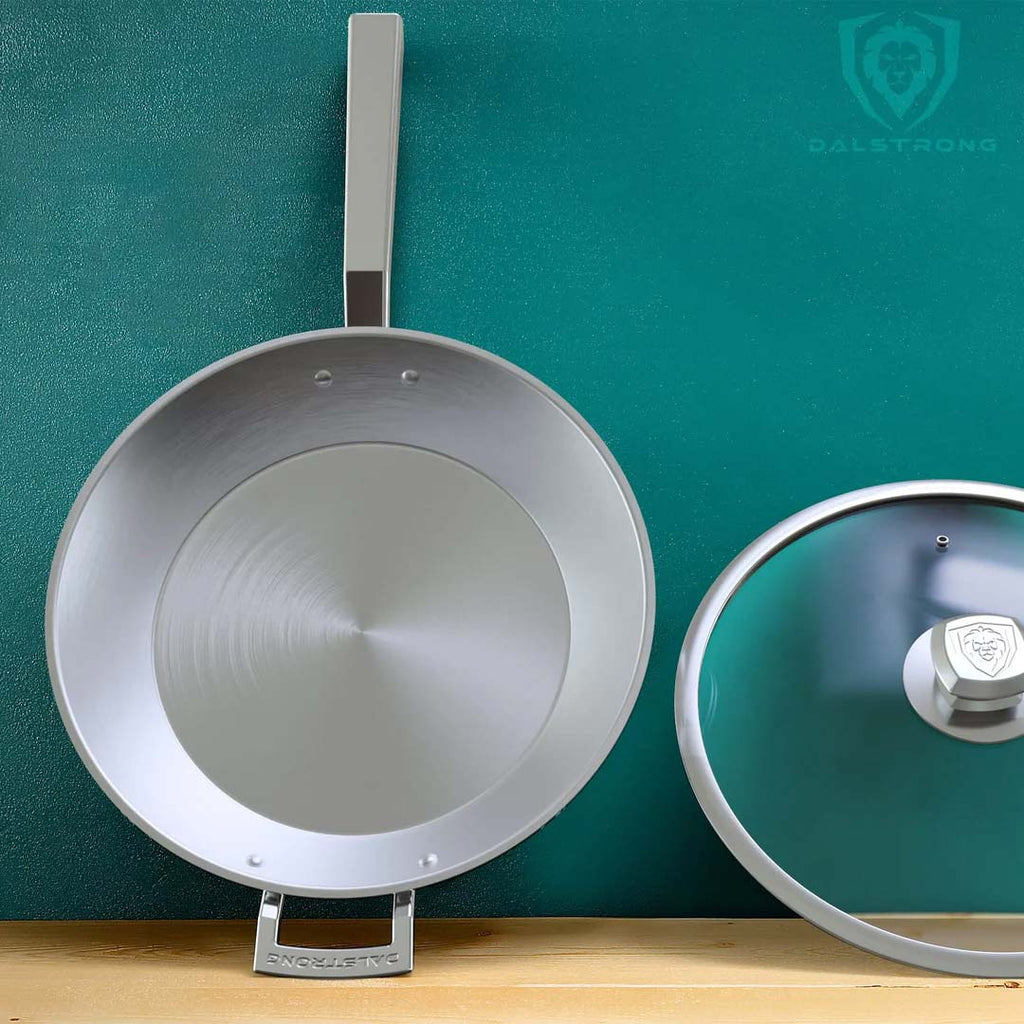 12" Frying Pan & Skillet | Silver | Oberon Series | Dalstrong
12" Frying Pan & Skillet | Silver | Oberon Series | Dalstrong
Whether you're making a chicken fried steak or even an upside-down carrot cake, there are many many uses for the mighty skillet. Learn all about what makes a good skillet, and what the best skillet recipes are, in this article.
1. What Is A Skillet And Why Do You Need One?
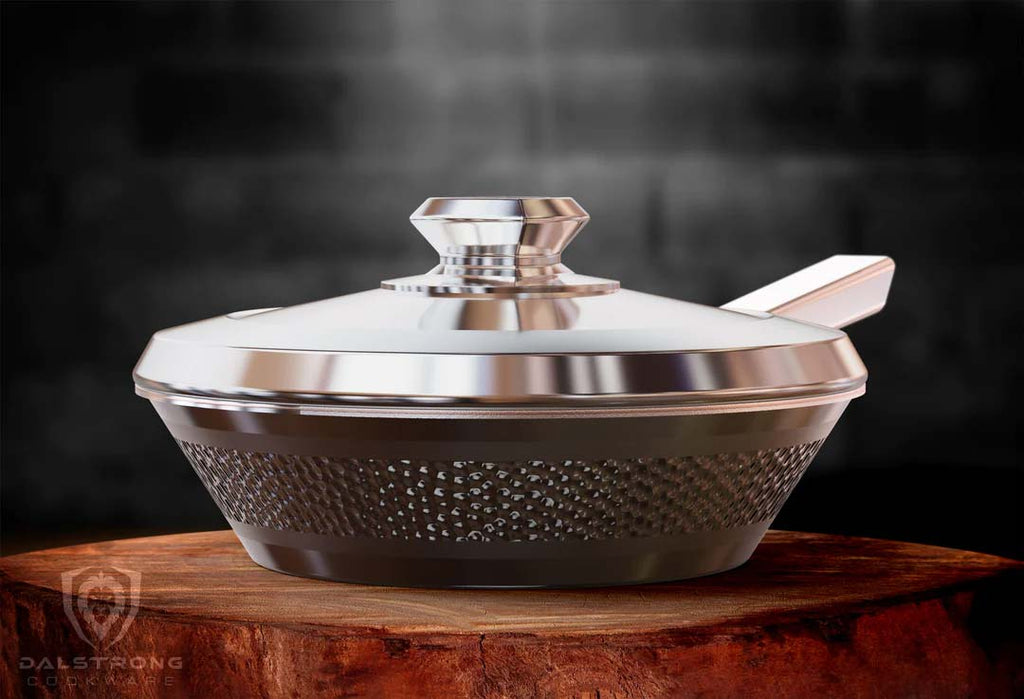 9" Frying Pan & Skillet | Hammered Finish Silver | Avalon Series | Dalstrong
9" Frying Pan & Skillet | Hammered Finish Silver | Avalon Series | Dalstrong
The skillet is the superhero of your kitchen – no cape needed, just a sturdy handle and a trusty cooking surface. And the cast iron skillet is the heavyweight champion of the kitchen. Perfect for getting that Instagram-worthy sear on a chicken thigh or simmering a rich and hearty chicken pot pie. Its ability to retain and evenly distribute heat makes it ideal for both stovetop searing and oven baking.
Then there's the enameled cast iron skillet – the sleek, less fussy cousin. Perfect for whipping up something a little fancy, like a coq au vin that would make Julia Child proud. Its enameled surface means you get all the benefits of cast iron without the hassle of seasoning and with an easier cleanup. Plus, it looks pretty snazzy on your stovetop.
And let's not forget the versatility factor.
Castiron skillets aren't just great for making dinner; they're an awesome tool for every meal. Craving a late-night snack? Whip up some fried rice in a jiffy. Planning a leisurely Sunday brunch? Impress your friends with a skillet cornbread that's as fluffy as a cloud. The skillet is your culinary canvas, ready for you to create everything from a simple grilled cheese to ground beef for your taco fillings, a skillet coffee cake, or an ambitious beef bourguignon.
A skillet is up for any cooking challenge you throw at it, and it'll help turn your dinner recipe dreams into delicious reality. So, whether you're a cooking newbie or a seasoned pro, a skillet is one investment you won't regret. Just imagine the sizzle of pork chops (or pork shoulder) or the aroma of apple pie baking in the oven – that's the magic of the skillet.
Read about how to store cast iron skillet, here.
2. Unique Characteristics Of A Skillet
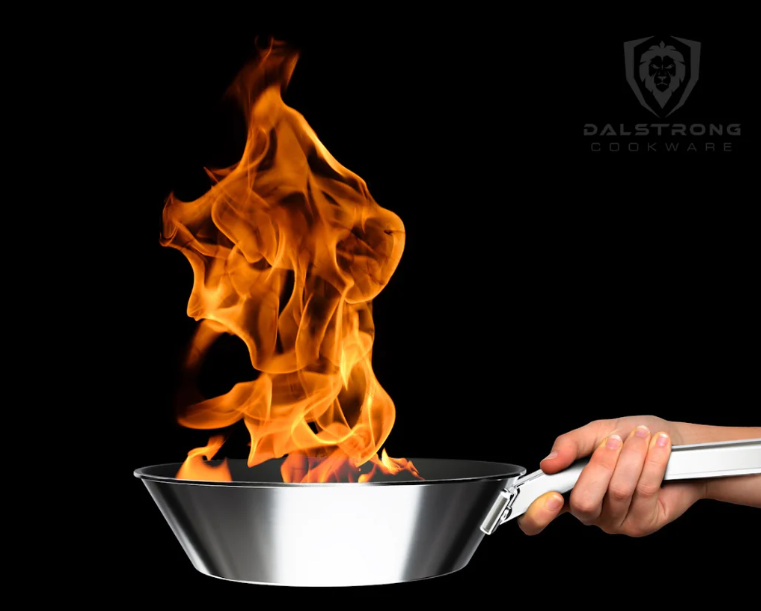 9" Frying Pan & Skillet | ETERNA Non-stick | Oberon Series | Dalstrong
9" Frying Pan & Skillet | ETERNA Non-stick | Oberon Series | Dalstrong
Dive into the world of skillets and you'll find there's so much to them. Take the classic Le Creusets, for instance. These skillets are the titans of the stove, known for their robust construction and stylish looks. They're like the luxury SUVs of the kitchen - strong, durable, and oh-so-chic. However, we've got some even better skillets to show you, that'll work for your kitchen and your wallet – scroll down to section 5 to see.
Cast iron skillet
Cast iron is the go-to for achieving that perfect sear on pork chops, making them sizzle with delight. It's the skillet you reach for when you're craving a golden, crispy crust that's the stuff of foodie dreams. And let's not forget about its magic with pot pies. A cast iron skillet turns a humble pot pie into a gourmet experience, baking it evenly and adding a touch of rustic charm to your dish. The only problem? They're hard to take care of.
Carbon steel skillet
Now, for those of us who love a quick and easy meal without sacrificing quality, carbon steel skillets are the unsung heroes. They heat up faster than their cast iron cousins, making them perfect for those nights when you want a simple skillet dinner without the wait. Plus, their lightweight nature means you can flip, toss, and sauté with the agility of a kitchen ninja.
Enameled cast iron skillets
As we mentioned, these are incredible when it comes to cleanup. After you've devoured that delicious skillet chicken, the last thing you want to do is scrub pots and pans. Enameled cast iron comes to the rescue here, with its smooth, non-reactive surface that's a breeze to clean. It's like having the brawn of cast iron without any of the cleanup battles.
Stainless steel skillet
Enter the shining knight of the kitchen, looking as bright and shiny as ever. Unlike its cast iron and carbon steel counterparts, stainless steel doesn't require seasoning. This means it's a low-maintenance option for those who'd rather not fuss over their cookware. It's the ideal choice for achieving a beautiful fond (those delightful caramelized bits) for sauces, thanks to its awesome heat distribution. And it's extremely versatile, too; a workhorse that's hard to beat for everyday cooking. And it's easily the nicest-looking skillet option around.
In essence, each type of skillet brings its own unique flair to the table. Whether it's the rugged charm of a cast iron skillet, the sleek efficiency of carbon steel, or the easy maintenance of enameled cast iron, there's a skillet out there for every cook and every meal. So next time you're in the kitchen, remember: your skillet isn't just a pan – it's your partner in creating culinary masterpieces.
3. Skillets vs. Pans: Are They Synonymous?
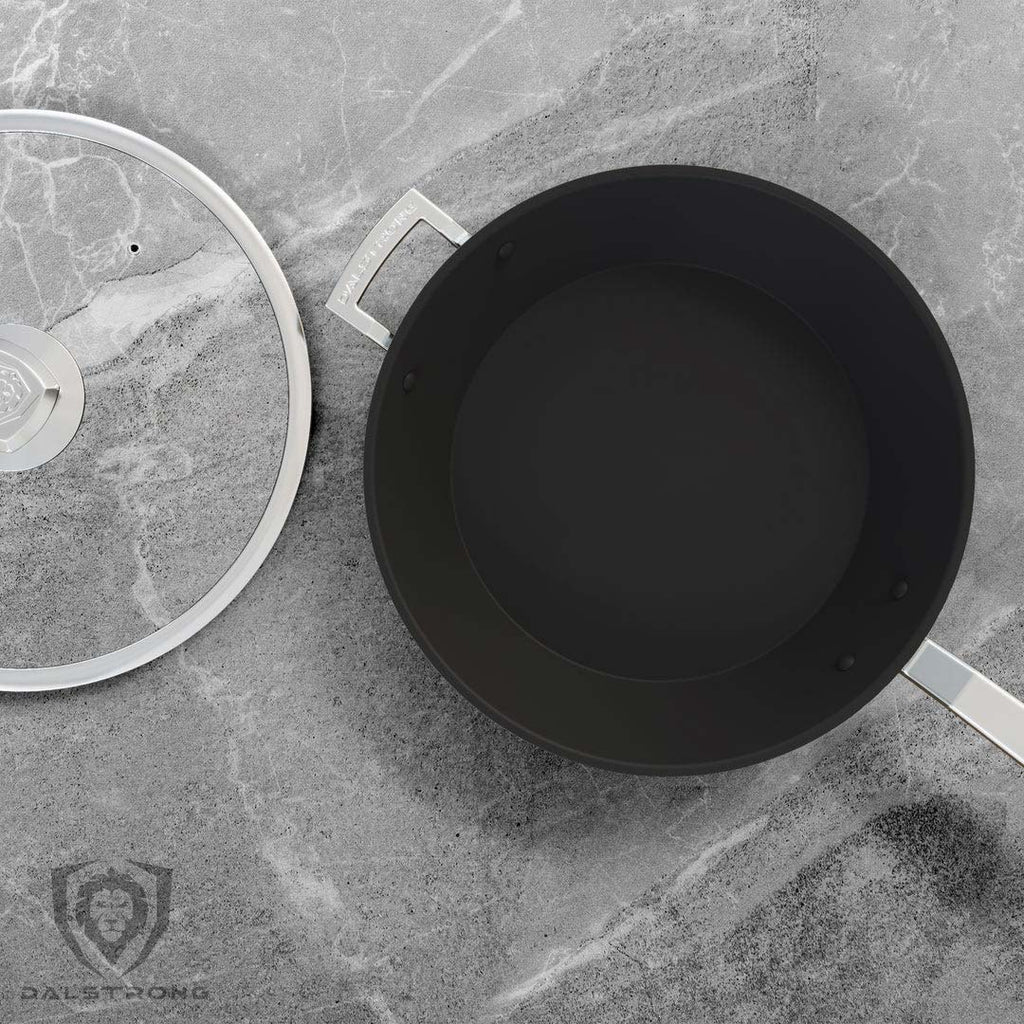 12" Frying Pan & Skillet | ETERNA Non-stick | Oberon Series | Dalstrong
12" Frying Pan & Skillet | ETERNA Non-stick | Oberon Series | Dalstrong
These terms are often used interchangeably, but are they really the same? Let's chat about what sets skillets apart from your average pans.
Shape
If you're flipping a pancake or an omelet like a pro, that's where the skillet shines – its sides are kind of flared or slanted, making it super easy to get under those pancakes for the perfect flip. And when it's time to serve? Just slide that golden-brown beauty right onto the plate. Now, pans, like your typical frying or sauté pan, have sides that stand up straighter. They're the go-to when you're dealing with more liquidy stuff – think simmering sauces or poaching eggs. They keep everything contained, no spillage here!
Depth
Depth-wise, skillets are usually not as deep as pans. They're kind of like the shallow end of the pool, great for a quick dip into cooking methods that need high heat and fast action, like searing a steak or frying up some bacon. Pans are deeper, more like the deep end. They're perfect when you're in the mood for something that needs a bit more liquid love, like a slow-cooked braise or a rolling boil for your pasta.
Materials
Skillets come in a bunch of materials. Cast iron skillets are probably the best, though. Known for hanging onto heat like it's their job and lasting forever, they're a kitchen favorite. But pans aren't left in the dust – they also come in a variety of materials, including cast iron. You'll often find pans in stainless steel, with nonstick surfaces, or even aluminum.
4. Some Of The Best Recipes For Skillet Cooking
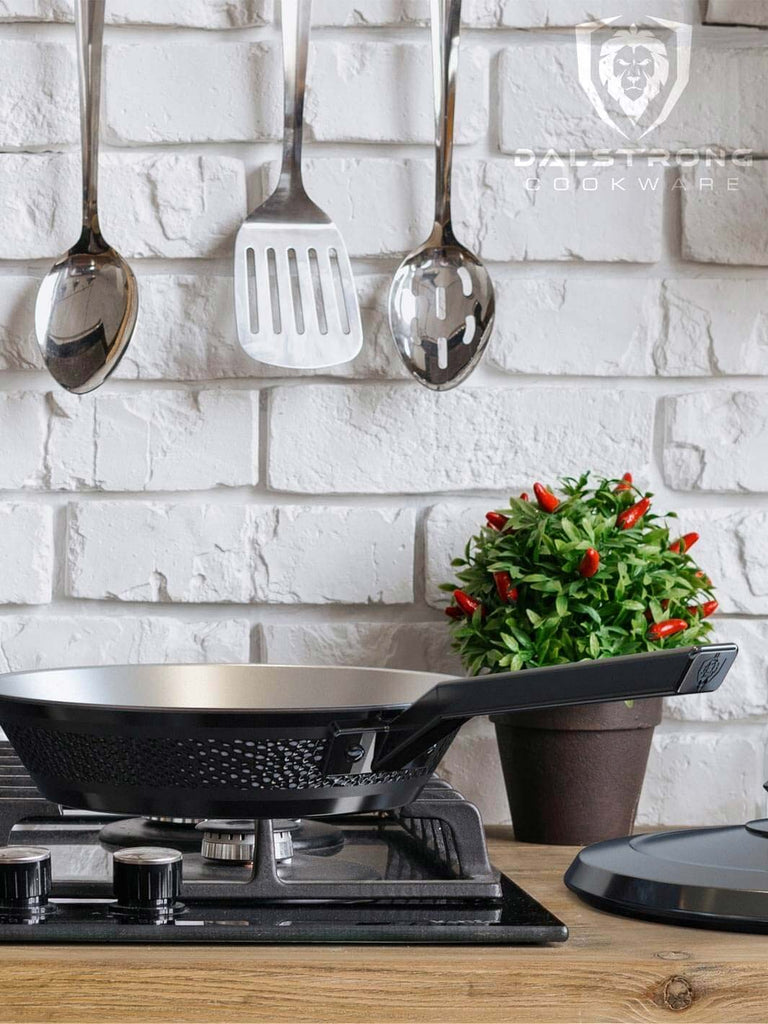 10" Frying Pan & Skillet | Hammered Finish Black | Avalon Series | Dalstrong
10" Frying Pan & Skillet | Hammered Finish Black | Avalon Series | Dalstrong
Alright, let's dive into the delicious world of skillet cooking with some top-tier recipes. Whether you're a newbie in the kitchen or a seasoned home chef looking to spice things up, there's a skillet recipe here for everyone. And to make things easier, we've provided one recipe for each different skill level. Let's get started…
Beginner: Easy skillet cornbread
If you're just starting out, you're probably looking for recipes that are straightforward, require basic techniques, and use minimal ingredients. As a beginner, you should feel comfortable with measuring ingredients, following simple instructions, and doing basic stovetop and oven work. This easy skillet cornbread makes a great starting point, since it's forgiving, fun, and a great intro to skillet cooking.
Ingredients:
- 1 cup yellow cornmeal
- 1 cup all-purpose flour
- 1/4 cup sugar (optional, for a touch of sweetness)
- 4 teaspoons baking powder
- 1/2 teaspoon salt
- 1 cup milk
- 1 large egg
- 1/4 cup unsalted butter, melted (plus a bit more for greasing the skillet)
Directions:
- Preheat and Prep: First things first, let's get that oven heating up. Preheat it to 425°F (220°C). While it's warming, take a little extra butter and use it to generously grease your cast iron skillet. This ensures your cornbread won't stick and gets a nice crust.
- Mix dry ingredients: In a large bowl, combine your dry ingredients – cornmeal, flour, sugar (if you like it a bit sweet), baking powder, and salt. Give it a good whisk to make sure everything's nicely mixed.
- Add wet ingredients: In a separate bowl, mix together the wet stuff – milk, egg, and melted butter. Whisk them together until everything is fully combined.
- Combine and cook: Now, pour the wet mixture into the dry ingredients. Stir them together just until combined. Don't overmix; a few lumps are totally fine. Overmixing can make the cornbread tough.
- Bake the bread: Pour your batter into the greased skillet. Smooth it out so it's nice and even. Pop it into the oven and bake for about 20-25 minutes. You'll know it's done when the top is golden and a toothpick inserted into the center comes out clean.
- Enjoy. Let your cornbread cool in the skillet for a few minutes. Then, cut into wedges and serve it up. It's amazing with chili, BBQ, or just on its own with a bit of honey butter.
That's it! A simple, satisfying introduction to skillet cooking. This recipe for easy cornbread will put you on the right track to starting your adventures in skillet cooking. This cornbread recipe is delicious and a real confidence booster. Once you've nailed this, you'll be ready to tackle more challenging skillet recipes.
Novice: One-skillet chicken thigh dinner
Okay. You're no longer at the starting gate. You've got the basics down and are comfortable with primary cooking techniques like sautéing, searing, and maybe even a bit of baking. Unlike a beginner, you're ready to handle multiple steps and ingredients. You understand the importance of seasoning and have a feel for when food is properly cooked. Now let's step up the game with a delicious one-skillet chicken thigh dinner – a perfect blend of flavors and textures, all in one pan.
Ingredients:
- 4 bone-in, skin-on chicken thighs
- Salt and freshly ground black pepper
- 2 tablespoons olive oil
- 1 onion, chopped
- 2 cloves garlic, minced
- 1 cup baby carrots
- 1 cup chicken stock
- Fresh herbs (like thyme or rosemary) for garnish
Directions:
- Prep and season: Start by preheating your oven to 375°F (190°C). While it heats up, let's get those chicken thighs ready. Season them generously on both sides with salt and pepper. This isn't just for flavor; it'll help get that skin nice and crispy.
- Sear the chicken: Here's where we make our onepan chicken dinner shine. Heat the olive oil in your skillet over medium-high heat. Once it’s shimmering, add the chicken thighs skin-side down. Sear them until the skin is golden and crispy, about 5-7 minutes. Flip them over and cook for another 3-4 minutes. Then remove the chicken from the skillet and set it aside.
- Veggies in the mix: In the same skillet, lower the heat to medium. Add the chopped onion and minced garlic, cooking until the onion is soft and translucent. Stir in the baby carrots and cook for a couple of minutes. This is where you build layers of flavor.
- Bring it together: Place the seared chicken thighs back in the skillet, on top of the veggies. Pour in the chicken stock – this will create a delicious sauce and ensure the chicken stays juicy.
- Oven time: Transfer the skillet to the preheated oven. Bake for about 25-30 minutes, or until the chicken is cooked through (internal temperature should reach 165°F or 75°C).
- Serve and enjoy: Garnish with fresh herbs, and you've got a stunning dish ready to impress. This one-skillet wonder offers a complete meal with protein and veggies, and the flavors are out of this world.
This recipe takes you a step further in your cooking journey, as it combines stovetop and oven techniques for a delicious result. It's a great recipe that works as a sort of bridge towards more complex dishes, boosting your confidence and culinary skills.
Intermediate: Italian sausage and hash browns breakfast
At this point you've journeyed beyond the basics and have a good handle on various cooking techniques. Unlike a novice, you're not just following recipes anymore; you're starting to understand how flavors and textures work together, and you're looking for more cooking tips. It's time to explore recipes that bring together diverse ingredients and require a bit of multitasking. Let's dive into a delicious Italian sausage and hash browns breakfast that's hearty enough for dinner.
Ingredients:
- 4 Italian sausages (about 1 pound)
- 2 cups frozen hash browns, thawed
- 1 small onion, diced
- 1 bell pepper, diced (color of your choice)
- 4 large eggs
- Salt and pepper, to taste
- 2 tablespoons olive oil, divided
- Fresh parsley or chives, chopped, for garnish
Directions:
- Cook the sausage: Start by heating 1 tablespoon of olive oil in your skillet over medium heat. Add the Italian sausages and cook them, turning occasionally, until they are fully cooked and browned on all sides. This should take about 10-12 minutes. Once done, transfer them to a plate and slice them into bite-sized pieces.
- Sauté the veggies: In the same skillet, add the diced onion and bell pepper. Sauté until the vegetables are soft and slightly caramelized, which brings out their natural sweetness. This should take about 5-7 minutes.
- Hash browns in action: Push the veggies to one side of the skillet. Add the remaining tablespoon of olive oil and spread the hash browns in a single layer on the other side. Season with salt and pepper. Let them cook undisturbed for a few minutes to get them nice and crispy on one side, then mix with the veggies and cook for another 5 minutes until they're golden and crispy all over.
- Add the sausage back: Toss the sliced sausages back into the skillet with the hash browns and veggies. Give everything a good mix to ensure that the flavors meld together.
- Fry the eggs: In a separate non-stick skillet, fry the eggs to your liking. A sunny side up or over-easy egg works great for this dish.
- Serve it up: Spoon the sausage-hash brown mixture onto plates, and top each with a fried egg. Sprinkle some chopped parsley or chives for a fresh touch.
This dish is a wonderful way to showcase your growing skills in the kitchen. It combines elements of timing, flavor pairing, and presents an opportunity to play with textures. As an intermediate cook, you'll appreciate how a simple breakfast dish can transform into an impressive and hearty meal.
Advanced: Skillet Coq Au Vin
You're in a different league at this point, having mastered the fundamental and intermediate skills in the kitchen. Unlike an intermediate cook, you're not just juggling multiple components; you're delving into more complex techniques and flavor profiles. You're comfortable with long-cooking dishes, experimenting with different cuisines, and aren't intimidated by a longer list of ingredients. Advanced cooks like you understand the nuances of balancing flavors and can adapt recipes to their taste.
Let's put those skills to the test with a classic French dish: Skillet Coq au Vin. This castiron skillet recipe requires patience and attention to detail, but the deep, rich flavors are your well-deserved reward.
Ingredients:
- 4 chicken thighs and 4 drumsticks (bone-in, skin-on)
- Salt and freshly ground black pepper
- 4 slices of bacon, chopped
- 1 large onion, finely chopped
- 2 carrots, sliced
- 2 cloves garlic, minced
- 1 pound mushrooms, sliced
- 2 tablespoons all-purpose flour
- 2 cups full-bodied red wine (like Burgundy or Pinot Noir)
- 1 cup chicken stock
- 2 tablespoons tomato paste
- A few sprigs of fresh thyme
- 2 bay leaves
- Chopped fresh parsley, for garnish
Directions:
- Prep the chicken: Season the chicken pieces generously with salt and pepper. In your skillet, cook the bacon over medium heat until crispy. Remove the bacon and set aside, leaving the fat in the skillet.
- Brown the chicken: Increase the heat to medium-high. Add the chicken pieces, skin-side down, and sear until the skin is golden brown, about 4-5 minutes per side. You may need to do this in batches. Remove the chicken and set aside.
- Cook the veggies: Reduce the heat to medium. In the same skillet, add the onion and carrots, cooking until they begin to soften. Add the garlic and mushrooms, cooking until the mushrooms are browned.
- Build the sauce: Sprinkle the flour over the veggies, stirring to coat. Pour in the wine, scraping up any browned bits from the bottom of the skillet. Stir in the chicken stock, tomato paste, thyme, and bay leaves. Bring to a simmer.
- Braise the chicken: Return the chicken and bacon to the skillet. Cover and simmer on low heat for about 45 minutes, until the chicken is tender.
- Final touches: Remove the bay leaves and thyme sprigs. Season with salt and pepper to taste. Garnish with chopped parsley before serving.
Coq au Vin is a dish that demands and showcases your advanced cooking abilities. It's about building layers of flavor, understanding the braising process, and balancing the richness of the sauce with the heartiness of the chicken. Dive into this project with enthusiasm and get ready for a truly satisfying culinary experience.
Challenge: Pineapple Upside-Down Cake
At this point, you're the kind of home cook who looks at a complex recipe and says "Bring it on!" You're not just mastering techniques and flavors; you're also embracing the art of presentation and precision. You're at a level where you're experimenting with more intricate dishes that require careful timing, temperature control, and often a bit of flair in the execution.
It's time to test your skills with a classic showstopper: the Pineapple Upside-Down Cake, a dessert that combines caramelization, careful batter preparation, and the all-important flip.
Ingredients:
- 1/4 cup unsalted butter
- 1/2 cup brown sugar
- 1 can (20 ounces) of pineapple slices, juice reserved
- 10 to 12 maraschino cherries
- 1 1/3 cups all-purpose flour
- 2/3 cup granulated sugar
- 2 teaspoons baking powder
- 1/4 teaspoon salt
- 1/2 cup unsalted butter, softened
- 2/3 cup reserved pineapple juice
- 2 large eggs
- 1 teaspoon vanilla extract
Directions:
- Prepare the caramelized topping: Preheat your oven to 350°F (175°C). Melt 1/4 cup butter in the skillet over medium heat. Add the brown sugar and stir until it's well blended with the butter and begins to bubble. Arrange the pineapple slices and cherries beautifully over the brown sugar mixture. This will be the top of your cake, so get creative with the pattern!
- Mix dry ingredients: In a bowl, whisk together the flour, granulated sugar, baking powder, and salt. This forms the base of your cake batter.
- Create the batter: In another bowl, beat 1/2 cup softened butter with the reserved pineapple juice, eggs, and vanilla extract until smooth. Gradually add the dry ingredients, mixing just until incorporated and smooth.
- Assemble the cake: Pour the cake batter over the pineapple and cherries in the skillet. Spread it evenly, taking care not to disturb your pineapple arrangement.
- Bake the cake: Bake for about 40-45 minutes, or until a toothpick inserted into the center of the cake comes out clean.
- The big flip: Here’s the moment of truth! Let the cake cool in the skillet for 10 minutes. Then, place a large plate over the skillet and, in one swift motion, flip the skillet over to invert the cake onto the plate. Lift off the skillet carefully, and voilà - your Pineapple Upside-Down Cake is ready to awe!
The process tests your ability to balance sweetness, texture, and aesthetics. It's a recipe that requires focus, finesse, and a bit of courage, especially at the flip. But master this, and you'll feel like a champion in the kitchen. Enjoy the applause (and the cake)!
As you can see, there's a lot you can do with skillets. You can make delicious recipes with ground beef, you can use them for frying chicken, making a tamale pie, bread pudding, roasted potatoes, and more. You can even put together an out-of-this-world amazing peach cobbler. The sky is truly the limit.
5. Dalstrong Must-Have Skillets
1. 12" Frying Pan & Skillet | Silver | Oberon Series | Dalstrong
The Dalstrong Oberon Series 12" Frying Pan & Skillet is an absolutely awesome piece of cookware. It features a 3-ply aluminum core, cladded with thick gauge layers of nonreactive 18/10 stainless steel. This fusion creates a pan with awesome conductivity and even cooking capabilities, perfect for everything from searing thick proteins to crafting delicate omelettes. Its cladding technology not only makes it highly durable but also enhances its ability to brown and braise foods.
PROS:
- Features a high performing 3-ply aluminum core and 18/10 stainless steel cladding, offering impeccable heat conductivity and even cooking.
- The skillet's durable construction and brushed finish induction bottom means it can be used on all stovetops, including induction, and resistant to denting or warping.
- Designed with an ergonomic handle and engraved side-handle, which means you'll have comfortable and secure handling during cooking and easy transitioning from stovetop to oven.
- Oven, broiler, freezer, dishwasher, and refrigerator safe..
CONS:
- The medium-weight of the skillet, while translating to great durability, might be slightly heavy for some users during prolonged cooking.
- The high-quality materials and advanced technology used in the skillet's design might come with a learning curve for those new to premium cookware.
2. 9" Frying Pan & Skillet | Oberon Series | Dalstrong
Here's a compact powerhouse in the kitchen. Crafted with a 3-ply aluminum core and enhanced with 18/10 stainless steel, it features a durable Eterna® non-stick coating that's free from PFOA and APEO. This skillet is designed to handle a wide range of dishes, from delicate omelettes to perfectly seared steaks. Its versatility is further highlighted by its compatibility with all stovetops, including induction, and its suitability for oven use up to 500 degrees F. The skillet is also freezer, dishwasher, and refrigerator safe, simplifying storage and cleaning.
PROS:
- Ideal for small kitchen tasks like frying a couple of eggs, sautéing vegetables, or cooking a single steak, thanks to its compact 9-inch size.
- The Eterna® non-stick surface is excellent for low-fat cooking, such as making delicate fish fillets or crepes, without worrying about sticking or tearing.
- Perfect for quick meals and easy clean-up, making it a go-to for busy individuals or small households.
- Its oven-safe feature allows for versatility in cooking techniques, such as starting a game day frittata on the stove and finishing it in the oven.
CONS:
- Its smaller size might not be enough for cooking larger meals or for those who frequently cook for bigger groups.
- The premium design and materials of the skillet may require more careful handling and storage compared to more basic cookware options.
3. 12" Frying Pan & Skillet | Oberon Series | Dalstrong
What sets this skillet apart is the Eterna® non-stick coating, renowned for its longevity and exceptional food release capabilities. It creates culinary magic with its impeccable conductivity and responsiveness to temperature changes. Its design ensures comfort and control, transforming every cooking session into an effortless experience. Oven, broiler, freezer, dishwasher, and refrigerator safe, this skillet stands out in both utility and elegance.
PROS:
- Features a high-quality Eterna® non-stick coating, proven to be 26 times more durable than leading competitors.
- It ensures even heat distribution and prevents warping, ideal for consistent cooking results.
- The skillet's versatile design and induction-ready bottom make it compatible with all stovetops.
- The ergonomic handle and engraved side-handle, coupled with non-stick covered rivets, provide a comfortable, secure grip. Comfortable and easy to handle.
CONS:
- The weight and professional-grade features might be more suited for experienced cooks rather than absolute beginners.
- The intricate design might not be to everyone's taste..
4. 12" Skillet Frying Pan | Avalon Series | Dalstrong
This awesome 12" skillet is a statement piece. Its Copper Core Foundation, sandwiched between layers of premium aluminum and nonreactive 18/10 stainless steel, provides excellent heat retention and even cooking. Its luxurious, eye-catching design offers both aesthetic appeal and superior performance. Compatible with all stovetops and optimized for induction, it is oven and broiler safe up to 600 degrees F, and also freezer, dishwasher, and refrigerator safe. This skillet, free from PFOA and PTFE, guarantees healthy cooking with its non-toxic, non-hypoallergenic materials.
PROS:
- Boasts a 5-ply Copper Forged Foundation that offers exceptional heat conductivity, heating 5X better than iron and 20X better than stainless steel for precise cooking.
- The combination of copper, aluminum, and 18/10 stainless steel layers ensures maximum heat retention and even cooking, enhancing the nutritional value and flavor of foods.
- Features a mirror-polished exterior with a brushed finish bottom, providing a secure grip on various stovetops and an underhand grip handle for comfortable cooking.
- Versatile and durable, this skillet is compatible with all stovetops, including induction, and is safe for use in the oven, broiler, freezer, dishwasher, and refrigerator.
CONS:
- The intricate 5-ply construction and premium materials might be more skillet than needed for casual cooks.
- The hammered finish looks awesome but it may not be for everyone, especially if you prefer a more understated look.
6. Frequently Asked Questions
What is the main purpose of a skillet?
The main purpose of a skillet is to provide a multi-functional cooking surface suitable for a wide range of cooking techniques. From skillet chicken to a fried egg, its design is perfect for quick and even cooking.
What is a cast iron skillet used for in cooking?
Castiron skillets are used for cooking dishes that require consistent heat and a surface that can go from stovetop to oven. They're great for searing meats, making a chicken pot pie, a tamale pie, or even baking an apple pie. There are many great castiron skillet recipe resources online.
What is the skillet to oven method of cooking?
The skillet to oven method involves starting a dish on the stovetop in a skillet and then transferring it to the oven to finish cooking. This method is perfect for dishes like skillet chicken that benefit from both searing and baking.
Can I make breakfast recipes in a skillet?
You certainly can make breakfast recipes in a skillet. It's excellent for frying chicken for a hearty morning meal, whipping up a fluffy omelet, or creating a delicate Dutch baby for an elegant spring breakfast. There's also a whole world of skillet brunch recipes out there. You can also have a skillet lunch, a skillet supper… It's even great for baking recipes. One of our favorite recipes is for a skillet coffee cake. The options are limitless!
Are skillet dinners only for savory dishes?
Skillet dinners are not limited to savory dishes. In fact, skillets are excellent for preparing both savory meals, like a pan dinner recipe with skillet chicken, and sweet treats, such as a classic apple pie or a peach cobbler.
Is it hard to maintain a cast iron skillet?
Maintaining a cast iron skillet is not difficult. Regular seasoning and proper cleaning will ensure your cast iron skillet remains a reliable cooking companion for a lifetime.




